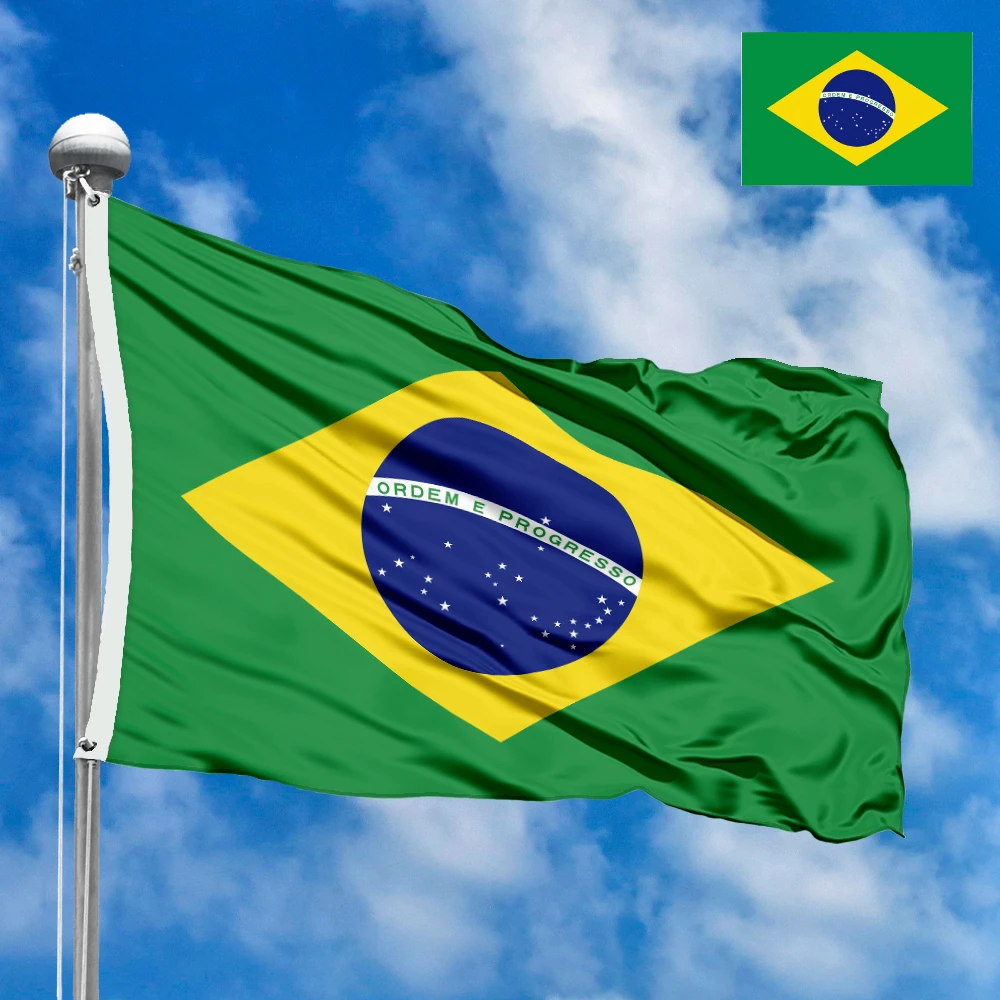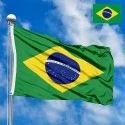The flag of Brazil is one of the most recognizable and symbolic flags in the world. With its vibrant green field, large yellow rhombus, and a unique celestial globe at its center, it is a powerful representation of the nation's rich nature, vast resources, and philosophical ideals. Known affectionately as the "Auriverde" (gold-green), the flag tells a story of a transition from monarchy to a republic.
A Detailed Look at the Flag's Design and Symbolism
The national flag of Brazil features a green field with a large yellow rhombus in the center. Within the rhombus, there is a blue celestial globe. A white band with the national motto, "Ordem e Progresso" (Order and Progress), runs across the globe. The globe is also filled with 27 white stars of various sizes, representing the country's Federal District and 26 states.
Each element of the flag has a specific, profound meaning:
-
Green Field: The green color represents Brazil's lush forests, vast Amazon rainforest, and rich agricultural lands. It symbolizes the country's vibrant biodiversity and its deep connection to the environment. The green field is a legacy of the Imperial flag, where it represented the House of Braganza, to which the first emperor of Brazil belonged.
-
Yellow Rhombus: The yellow rhombus symbolizes Brazil's mineral wealth, particularly its abundant gold reserves. It represents the country's economic prosperity and its vast natural resources. This element also originates from the Imperial flag, where it represented the House of Habsburg, the dynasty of the first empress.
-
Blue Celestial Globe: The celestial globe represents the sky over Rio de Janeiro at 8:30 a.m. on November 15, 1889, the day the Republic of Brazil was proclaimed. It is a scientifically accurate representation of the constellations visible at that time.
-
Stars: The 27 stars on the globe are arranged to represent the night sky and each corresponds to a specific federal unit of Brazil. The stars are not placed randomly; they correspond to real constellations, each with a designated state. For example, the star Spica in the constellation Virgo represents the state of Pará, while the star representing the Federal District is the only star above the motto. The number of stars has changed over time as new states were created or added, with the latest addition in 1992.
-
"Ordem e Progresso": The national motto, "Ordem e Progresso," which translates to "Order and Progress," is inspired by the positivist philosophy of French philosopher Auguste Comte. The motto reflects the belief that a society's advancement relies on both social order and scientific progress. It serves as a guiding principle for the nation.
The History and Creation of the Flag
The history of the Brazilian flag is a journey from a monarchy to a republic. The current design is a direct evolution of the Imperial flag, which was adopted in 1822. The Imperial flag had a green field and a yellow rhombus with the Coat of Arms of the Brazilian Empire in the center.
When the monarchy was overthrown and the Republic of Brazil was proclaimed on November 15, 1889, the government needed a new flag to symbolize the new era. The current flag was designed by Raimundo Teixeira Mendes with input from other positivists and was officially adopted on November 19, 1889. The designers chose to retain the green and yellow elements of the imperial flag, symbolizing the continuity of the Brazilian nation, but replaced the imperial coat of arms with the celestial globe and the national motto.
The most significant change to the flag over the years has been the number of stars. The original flag had 21 stars, representing the 20 states and the Federal District at the time. As Brazil grew and new states were formed, the number of stars was updated. The most recent change occurred in 1992 with the addition of four new stars to represent the states of Amapá, Roraima, Rondônia, and Tocantins, bringing the total to the current 27.
Meaning and Significance for Residents
For Brazilians, the flag is a profound symbol of national pride and unity. The flag's colors evoke a sense of connection to their natural environment and its abundant resources. The celestial globe, a unique feature among national flags, represents the nation's aspirations for a future built on science and order. The motto "Ordem e Progresso" is a source of both inspiration and reflection, encapsulating the philosophical ideals that underpin the republic. The flag is proudly displayed on all public buildings and is an integral part of national celebrations, particularly during Independence Day (September 7th) and Republic Proclamation Day (November 15th). It serves as a unifying symbol that transcends regional differences, reminding a diverse population of their shared identity and common destiny.
Interesting Facts
-
The nickname of the flag, "Auriverde," is a portmanteau of "ouro" (gold) and "verde" (green), reflecting the colors that dominate the design.
-
The arrangement of the 27 stars on the flag is a scientifically accurate representation of the night sky, making it one of the few national flags with an astronomical basis.
-
The motto "Ordem e Progresso" is a direct reference to the positivist philosophy of Auguste Comte, whose work was highly influential among the intellectuals who led the transition to the republic.
-
The stars on the flag are arranged to be seen as if looking at the sky from outside the celestial sphere. This is a perspective that is unusual but essential for a cartographic representation of the sky.
-
The flag is so revered that there is a Flag Day in Brazil (November 19th), which is a national holiday dedicated to honoring the flag and its symbolism.
In the demonstration images, full-size flags are shown with proportions of 2:3, and hand-held flags with proportions of 1:2.






 Waving flag
Waving flag
 Sizes:
Sizes:
 Round flag
Round flag
 Sizes:
Sizes:
 Rectangular flag 2:3
Rectangular flag 2:3
 Sizes:
Sizes: